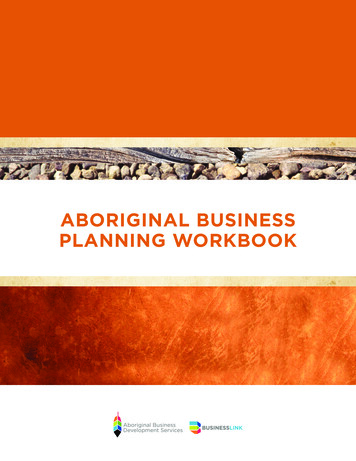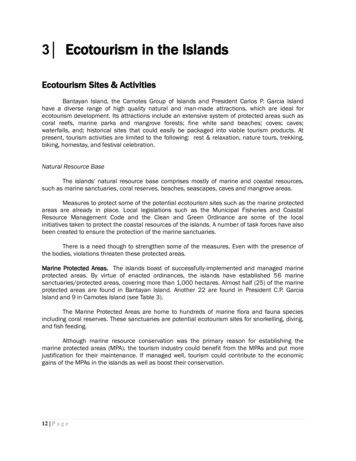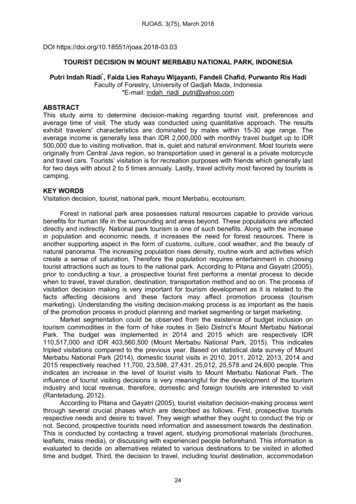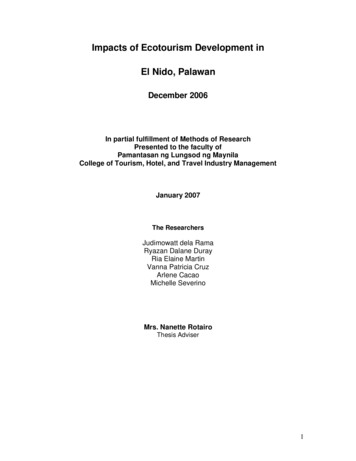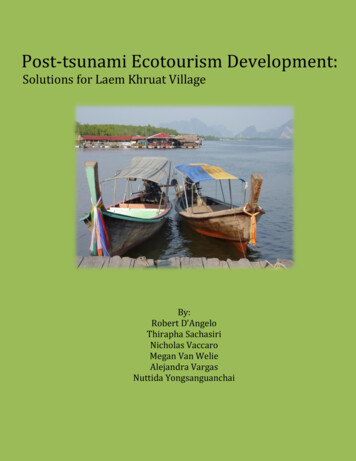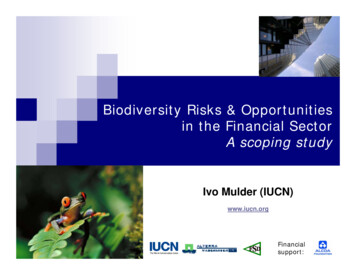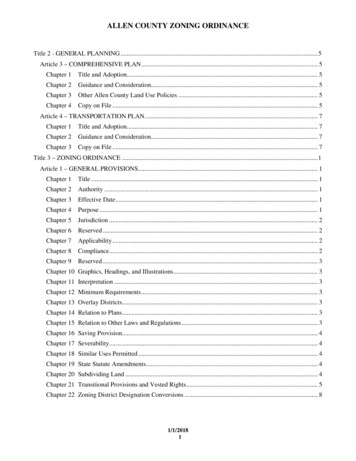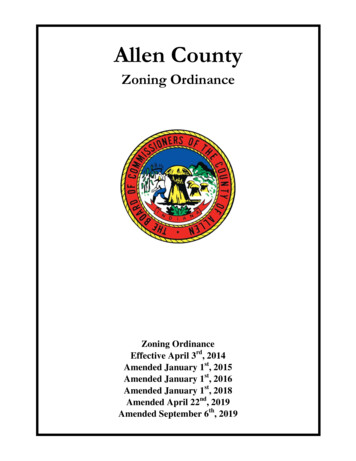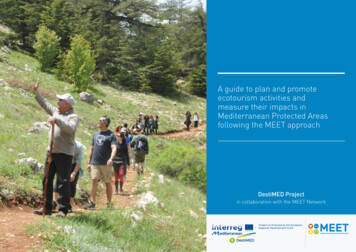
Transcription
A guide to plan and promoteecotourism activities andmeasure their impacts inMediterranean Protected Areasfollowing the MEET approachDestiMED Projectin collaboration with the MEET Network
2Lastovo Islands Natural Reserve, Croatia DestiMED project
CREDITSThe designation of geographical entities in this book andthe presentation of the material, do not imply the expressionof any opinion whatsoever on the part of MedPAN or anyother DestiMED partner, concerning the legal status of anycountry, territory, or area, or of its authorities, or concerningthe delimitation of its frontiers or boundaries.This publication reflects only the author’s view. The contentsof this report can in no way be taken to reflect the views ofthe European Commission.Reproduction of this publication for educational and othernon-commercial purposed is authorized without prior writtenpermission from the copyright holder provided the sourcesare fully acknowledged. Reproduction of this publication forresale or other commercial purposes is prohibited withoutwritten permission of the copyright holder.This report was produced in the framework of DestiMED, aproject of the EU Interreg MED programme and co-financedby the European Regional Development Fund.Editor: Magali Mabari, MedPANProduced by: MedPAN, Marseille, FranceWritten by: Daniel Noll, Audrey Scott, Carla Danelutti, JeremySampson, Alessandro Galli, Serena Mancini, Iacopo Sinibaldi,Luca Santarossa, Mosor Prvan, Marianne Lang.Coordinated by: Irene Morell, Marianne Lang (MedPAN)Citation: Noll, D., Scott A., Danelutti, C., Sampson J., GalliA., Mancini S., Sinibaldi I., Santarossa L., Prvan M., LangM. (2019). A guide to plan and promote ecotourism activitiesand measure their impacts in Mediterranean Protected Areasfollowing the MEET approach. DestiMED project, InterregMed Programme. 112 pp.Design: Kinga BejCover: Al Shouf Biosphere Reserve, Lebanon DestiMED projectAvailable from: www.medpan.org 2019 MedPAN3
ACKNOWLEDGEMENTS4This Manual was produced by the DestiMEDpartners, under the coordination of MedPANAssociation and in collaboration with theMEET Network Association. Funding for thisedition of the manual was provided by theInterreg-MED Programme.The partners of DestiMED and MEET projects would like to thankall the individuals and organizations which provided valuableinput in the development of this manual, either by reviewing andsharing feedback on its contents, providing information or simplyhaving been part of the process that led to this publication, andspecifically:This Manual is based on, and represents anexpanded and updated edition of the firstMEET Manual, that was published in 2016and produced by the Centre for MediterraneanCooperation of the International Union forthe Conservation of Nature (IUCN-Med), incollaboration with the other partners of theMEET project and with the financial supportof the MAVA foundation.Authors, 1st edition:The current edition of the manual is thereforethe result of a process of collaboration thatbegan in 2013 within the framework of theMEET Project, financed by the EuropeanNeighborhood Policy Instrument (ENPI-CBDMed) and continued from 2016 with theDestiMED project, funded by the InterregMED Programme.Reviewers of the 1st and 2nd editions:Andy Drumm (Drumm Consulting and IUCN WCPA)Arnaldo Rodriguez (Drumm Consulting)Carla Danelutti (IUCN - Centre for Mediterranean cooperation)Luca Santarossa (Italian Federation of Parks, Federparchi, Italy)Co-Authors, 2nd edition:Daniel Noll (Uncornered Market)Audrey Scott (Uncornered Market)Marianne Lang (MedPAN)Jeremy Sampson (IUCN - Centre for Mediterranean cooperation)Carla Danelutti (IUCN - Centre for Mediterranean cooperation)Alessandro Galli, Ph.D. (Global Footprint Network)Maria Serena Mancini (Global Footprint Network)Iacopo Sinibaldi (Lazio Region)Mauro Randone (WWF Mediterranean)Luca Santarossa (Federparchi)Jula Selmani (Albanian National Protected Areas Agency)Natalie Lobartolo(former IUCN - Centre for Mediterranean cooperation)Filippo Belissario (Monte Rufeno Regional Park)Stefania Petrosillo (Europarc Federation)Contributorsof the 1st and 2nd edition:Kamal Abou Assi(former Al Shouf Cedar Society)Antonis Barnias (Samaria National Park)Quico Balguer Nuñez (KikBalanga)Lourdes Lázaro (IUCN - Centre for Mediterranean cooperation)Ángeles de Andrés (ECOTONO)Chloë Webster (former MedPAN)Pascal Abdallah (Responsible Mobilities)Estefanía Fuentes (Catalunya Region)Muna Haddad (former Royal Society forthe Conservation of Nature)Daniella Sachs (Sustainable TravelInternational)Nizar Hani (Al Shouf Cedar Society)Alaa Mujahed (former Royal Society forthe Conservation of Nature)Ferdinando Rossi (Lazio Region)Anne Lépine (former Parcs Nationaux de France)Hany El Shaer (IUCN ROWA)Lubna Qaryouti (former IUCN ROWA)Nuria Sendros (Catalunya Region)In addition, a final thanks to all protected area staff, localtourism partners, service providers, tour operators, and testerswho have accompanied us during our adventures over the lastseveral years, who have made the approach, the methodology,and this document possible.
PURPOSE AND ORGANIZATIONOF THIS MANUALIl-Majjistral Nature andHistory Park, Malta MajistralThe purpose of this manual is to provide protected areamanaging bodies and the local ecotourism sector with a clearpathway to plan and enhance engaged conservation-focusedecotourism in their areas.This manual intends to encourage and engage protectedareas and sustainable local business in joint initiatives whichcontribute to protected area conservation – by enabling thecreation of ecotourism products based on the approach andmethodology initially piloted by the MEET project and laterdeveloped and refined by DestiMED project, and henceforthreferred to as the “MEET approach”.The MEET approach envisages the development of ecotourismproducts in Protected Areas through the establishment of aLocal Ecotourism Cluster (LEC), a private-public tourismcluster supported by the protected area and composed ofmulti-sector stakeholders (see Chapter 2). The approach alsohelps involved actors in understanding and managing impactsof the product, and in proactively managing it through a seriesof criteria and supporting tools.This manual is specifically focused on developing ecotourismproducts that satisfy criteria in order for the Protected Areato become a part of the Mediterranean Experience of Ecotourism (MEET) Network. The MEET Network is a networkof Mediterranean Protected areas, born as a start-up fromEU-funded initiatives (the MEET and later DestiMED projects) and designed to harness the potential of ecotourismin the region while being mindful of its conservation. Sinceits beginning as a cooperation project, MEET has involvednearly 40 protected areas in 11 countries. Today, as a formalized network, it continues to integrate new protectedareas to expand the conservation and economic benefits ofsustainable, respectful and nature-oriented tourism acrossthe Mediterranean Basin.Even though the manual specifically address ecotourismproducts that can meet criteria in order to be promotedthrough the MEET Network, most of the concepts, guidanceand tools presented can be equally applied by any protected area that wants to promote ecotourism activities in itsterritory by adopting a robust participatory approach and byencouraging the development of products that meet a set ofcriteria in order to be really qualified as “ecotourism”. In thissense, this manual can be more generally regarded as a toolto initiate, or further promote, the planning and developmentof ecotourism in any Protected Area of the Mediterranean.The following is a high-level chapter outline. Within eachchapter, basic concepts are introduced along with their rationale. This is followed by an explanation of the process and/orits components in the MEET Network context. Chapters alsoinclude Case Study insets designed to highlight examples ofsuccessful application of the process and/or lessons learnedby various participants throughout the establishment of theMEET Network.CHAPTER 1The MEET concept and its rationale.Includes a brief background on tourismin the Mediterranean and its protected areas.CHAPTER 2Establishment and maintenance of a LocalEcotourism Cluster (LEC) to satisfy MEET criteriaand to manage the creation, monitoring and iterationof a MEET ecotourism product.CHAPTER 3The basic components and developmentof a MEET ecotourism product.CHAPTER 4Monitoring and measuring the quality andsustainability of MEET ecotourism products, includingthe application of the Ecological Footprint methodology.CHAPTER 5Marketing through the MEET Network. Addressesproduct, pricing and promotion specific to MEETecotourism products.CHAPTER 6General sustainability and conservation considerationsfor protected area members of the MEET Network.GLOSSARYLists working definitions of common terms whichappear throughout the manual.ANNEXContains working copies or links to available forms,applications and templates relevant to the MEETNetwork process.REFERENCESA brief bibliographic listing of scientific/technicalmaterials and working documents referencedin the creation of this manual.5
Camargue Regional Natural Park, France Vialet - PNR
TABLE OF CONTENTS 1/3ACKNOWLEDGEMENTS.4PURPOSE AND ORGANIZATION OF THIS MANUAL.5CHAPTER 1INTRODUCTION.Protected Areas as a Tourism Development Opportunity.The MEET Network.The Origins and Future of MEET.Box 1: The European Charter for Sustainable Tourism in Protected Areas (ECST).119101213CHAPTER 2DEVELOPING AND MANAGINGA LOCAL ECOTOURISM CLUSTER (LEC).19What is a Tourism Cluster and MEET Local Ecotourism Cluster (LEC)?.Tourism Cluster and MEET Local Ecotourism Cluster Definitions.Tourism Clusters and the Tourism Economy (Value Chain).Benefits of a Strong Tourism Cluster.20202020Local Ecotourism Cluster (LEC): Composition and Formation.LEC Composition and Participants.Forming a LEC: Existing vs. New Structures.Box 2: Case Study: Sierra Nevada National Park:How MEET Complements the ECST Process.LEC Formation: A Step by Step Process.242527LEC Roles and Responsibilities.Product Development and Improvement.Measurement and Monitoring.Ongoing Management of the LEC.Box 3: Case Study: Successful formation and managementof a LEC -- National Park of “Colline Metallifere Grossetane»Tuscan Mining UNESCO Geopark.303131322828337
TABLE OF CONTENTS 2/3CHAPTER 3CREATING A MEET ECOTOURISM PRODUCT IN YOUR AREA.34Tourism and Ecotourism Products.What is a Tourism Product?.Elements of an Ecotourism Product.343435A MEET Ecotourism Product’s Unique Selling Proposition (USP).MEET Target Markets.Suggested Activities to be Included in a MEET Ecotourism Product.Box 4: Case Study: The conservation activityin Camargue regional nature park, France.373839How to Satisfy the MEET Criteria for an Ecotourism Product.Ecotourism Product Design.Conservation and Sustainability.Cultural Considerations.Guiding and Interpretation.Accommodation.Food & Drink.Safety.Communication Before and During the Tour.414142434444454647Describing Your MEET Ecotourism Product to the Market.Box 5 Case study: How a small nature reserve in Italy createda unique ecotourism product.48The Importance of Interpretation and Guidingto a MEET Ecotourism Product.What is Interpretation?.841494950Box 6: How to write a theme.Box 7: Case Study: Using interpretationin the Azraq Wetland Reserve, Jordan.The Role of Guides in Conservation.CHAPTER 4MEASURING AND MONITORING MEET ECOTOURISMPRODUCT QUALITY AND SUSTAINABILITY.51525254MEET Ecotourism Standard and Its Pillars.Criteria and Indicators for Managing Quality and Sustainabilityof Ecotourism Products.Assessment of Product Suppliers.Measuring Sustainability: Ecological Footprint Methodology.Ecological Footprint Data Collection and Responsibilities.Ecological Footprint Calculation Tool and Results.Box 8: General Ecological Footprint recommendationsfor all PAs and LECs.Box 9: Case Study: Evolving a MEET ecotourism productat Samaria National Park: Using the Ecological Footprintto achieve a lower food Footprint.Measuring Quality of the Guest Experience: Satisfaction Surveys.54Evaluation of Products for Inclusion into the MEET Guide.Box 10: Case Study: Improving a tourism productafter receiving feedback from testing. (Kornati National Park).63Performance Monitoring Report Card.67555657585959616265
TABLE OF CONTENTS 3/3CHAPTER 5MARKETING THROUGH THE MEET NETWORK.68Pricing.Calculating the Cost and Profitability of your Product.MEET Branding.Brand Name.Brand Pillars.Brand Promise.Brand Values.Box 11: Storytelling and MEET.The MEET Guide.Purpose of the MEET Guide.Fine-Tuning of Products through Evaluation.6870727273737374747476CHAPTER 6INCORPORATING ELEMENTS OF SUSTAINABILITY.78Key Elements of Sustainability.Interpretation in Visitor Centers, Signs and Printed Materials.7979Visitor Impact Monitoring and Management.Zoning for Visitor Use.Visitor Management Strategies and Alternatives.Establishing Limits of Acceptable Change.Box 12: LAC: a case study from Mingha-Deception Trackin the Arthur’s Pass National Park (New Zealand).80818181How Tourism Supports Protected Areas.Box 13: The Threshold of SARY.91ANNEXES.929395Annex 1: MEET Membership Phases and Process Overview.Annex 2: MEET Ecotourism Standard.Annex 3: Example of content of an EcotourismStrategic plan structure .Annex 4: Example of collaboration agreementamong park and ITO. .Annex 5: Example of a MEET programme.9899839
The Mediterranean :1st worldwide tourismdestinationYearly tourist arrivalsare blooming197058 millions2014300 millions50 % in coastal zonesby 2030500 millionsSource: Medtrends,UNWTO Tourism highlights 2014INTERNATIONALTOURIST ARRIVALSBY COUNTRY IN 2012X 1,000MediterraneanEU COUNTRY
INTRODUCTIONCHAPTER 1INTRODUCTIONThe Mediterranean Basin, which extends across two millionsquare kilometers and 34 countries, east from Portugal toJordan, and south from northern Italy to Cape Verde, is oneof 34 biodiversity hotspots identified around the globe, andone of Earth’s most biologically rich yet threatened areas. Inaddition to its biological and geographic wonders, the regionis a treasure trove of human history and culture and is home1Port-Cros National Park, France PNPCto some of the world’s earliest civilizations. However, despiteits importance, many immediate and long-term threats tobiodiversity and local cultures persist, including the region’sreliance on revenue from mass tourism. Growing populationand increased tourist flow to the region only exacerbate thisthreat, causing further strains on limited marine and terrestrial resources.11
Protected areasin the Mediterraneanneed a new model of tourism,one that is offered as analternative to mass tourism.””According to the UN World Tourism Organization (UNWTO),the Mediterranean is the world’s leading tourism destination,in terms of domestic and international tourism. The regionreceives more than 300 million international tourist arrivals,representing 30% of total world tourists for 2014: half ofthese arrivals are in coastal areas. International tourist arrivalshave grown from 58 million in 1970 to nearly 314 million in2014, with a forecast of 500 million by 2030. Tourism in theMediterranean region is highly concentrated, both spatiallyand seasonally, with most visits occurring during the summermonths. Coastal tourism is the largest sea-related economicactivity in the Mediterranean, with 11.3 of the regional GDP1.It is evident therefore that tourism represents an importantsource of revenues and employment in the Mediterraneanarea. At the same time, it implicates enormous negativeimpacts for nature and society.However, demand for alternatives to conventional, masstourism is growing around the world as more tourists seekto experience nature and authentic culture in a respectful,low impact way.With large numbers already flowing into Mediterranean protected areas, the obvious question is: Why develop even moretourism in the region?Protected areas in the Mediterranean need a new model oftourism, one that is offered as an alternative to mass tourism.12Peninsola del Sinis - Isola di mal di ventre MPA, Italy E. Trainito
INTRODUCTION1The new model should ensure that tourism’s impact on naturecan be minimized, local cultures are respected and economicbenefits may be distributed among local communities. Bycreating a new paradigm for the development of ecotourismproducts, protected areas can benefit from the shift fromconventional to sustainable tourism using mechanisms tomonitor and manage tourism-generated impacts.According to one of the most widely accepted definitions ofthis term2, ecotourism is defined in this manual as: “Environmentally responsible visiting of relatively unspoilt naturalareas, in order to enjoy and appreciate nature (and anyaccompanying cultural features - both past and present), thatpromotes conservation, has low negative visitor impact, andprovides for beneficially active socio-economic involvementof local populations.”Ecotourism is widely regarded as a form of tourism that respectsnature and culture, engages local people, brings significanteconomic benefits to local communities, and minimizes thedisruptive effects associated with mass tourism.The MEET approach particularly considers ecotourism as takingplace in and around areas which are protected, i.e. in anyareas that can be identified as “ a clearly defined geographicalspace, recognised, dedicated and managed, through legal orother effective means, to achieve the long term conservationof nature with associated ecosystem services and culturalvalues” (IUCN Definition 2008).Peninsola del Sinis - Isola di mal di ventre MPA, Italy E. TrainitoPort-Cros National Park, France @ G. HarmelinEcotourism products in protected areas have the opportunityto integrate local communities with a wide array of stakeholders including local travel agencies, local guides, farmers,artisans, hotel and restaurant owners, nonprofit organizations,public sector agents, and protected area managers. If thisintegration is well executed, it creates strong incentives forlocal communities for nature conservation, by linking economicbenefits to healthy, well-managed protected areas.13
Protected Areas asa Tourism DevelopmentOpportunityIn the Mediterranean,protected areas are amongthe best examples of a balancedrelationship between manand territory””Around the world visitors are increasingly travelling to destinations where they can experience unique natural attributes andauthentic manifestations of local culture. This phenomenonof market demand offers the potential to generate significanteconomic benefit for communities living in and around parksand other protected areas. These protected areas typicallyrepresent a country’s most significant flora, fauna, landscapesand geological formations and, in the Mediterranean case, areamong the best examples of a balanced relationship betweenman and territory. They provide opportunities for visitors toexperience powerful manifestations of nature and culture andto learn about the importance of biodiversity conservationand local cultural preservation. When such opportunities aremanaged sustainably, they can:Give economic value to ecosystem servicesthat protected areas provide.Generate direct and indirect income for localstakeholders, creating incentives for conservationin local communities.Diversify conventional tourism modelsto include ecotourism.Attract travelers, in niche market segments,who exhibit higher spending capacities.Stimulate new business opportunities which directlyand indirectly support ecotourism productexperiences in and around protected areas(e.g. food, handicrafts, rentals, outdoor shopsand wildlife guides).Strengthen destinations through stakeholder collaboration in the development and/or consolidation oflocal clusters, thereby increasing economic benefits.Gain the attention of local, regional and nationalgovernment agencies, convincing them thatprotected areas are destinations worth promotingand supporting.Generate local incentives to educate about protected areas and natural resources and to build localcapacity in guiding techniques, customer service andforeign languages.These and other opportunities illustrate the potential valueof leveraging protected areas, particularly in lesser-knownareas of the Mediterranean.Al Shouf Biosphere Reserve, Lebanon DestiMED project14
INTRODUCTIONThe MEETNetworkEcotourism in the Mediterranean offers significant untappedpotential. The high diversity of flora, fauna, landscapes,ecosystems, unique cultural mosaics, and rich heritagetogether provide exceptional conditions for the developmentof ecotourism products.The Mediterranean Experience of Ecotourism (MEET) is a target-oriented network of protected areas and key organizationsmanaging ecotourism products built around the natural andcultural attractions of protected areas and local communities.MEET is a conservation effort at its core, designed to support parks in the Mediterranean which play a critical role inprotecting the region s threatened biodiversity. The networkintends to act as a Destination Management Organization(DMO) representing the involved protected areas and featuresa support structure that facilitates the design, management,marketing and sales of these products by incorporating theminto unique destination portfolio (MEET Guide) with strongbranding and professional support. The overarching sharedobjective of the network is to strengthen the conservation ofprotected areas while respecting the local culture and historyof, and generating economic benefits for the communitiesthat live in and around them.The MEET Network has been developed to support ecotourism experiences which foster authentic exchanges betweenvisitors, local people, and nature, in what is traditionally amass-tourism ‘sun, sand and sea’ vacation region. Instead,MEET focuses on what we call 4C Tourism: Compassion,Connection, Community, and Conservation.This is integrated intothe MEET brand values as:We help to inspire meaningfulconnections with the people, placesand culture of the region.We engage with and striveto understand visitors, each other,and the region’s biodiversity andheritage.Conservation is at the heart of whatwe do: the long-term sustainability ofpeople and places is fundamental tothe brand experience.1How does MEETsupport parks?MEET supports Protected Areas withimplementing the MEET ProductDevelopment Protocol at local level.What does this look like ?We embrace the concept ofcollective impact and the cooperativerelationship between protected areasand the local communities.Thus MEET is about more than just creating a better holiday: the MEET Networkwants to offer a range of itineraries which are designed to harness tourism in a waywhich contributes to the critical conservation of both protected areas and localcultures in the region. Each park has collaborated over several years with a teamof local travel suppliers to design and refine the products. Itineraries in the MEETGuide have achieved high standards of quality and sustainability.1LOCAL ECOTOURISMCLUSTER DEVELOPMENT2ECOTOURISM PRODUCTDEVELOPMENT3QUALITY AND SUSTAINABILIYASSESSMENT AND MONITORING4MARKET ACCESS THROUGHCOMMERCIAL ENTITY15
The Originsand Future of MEETThe MEET Network is the result of two cross-border cooperation projects: MEET (2013-2015) funded by the EuropeanNeighborhood Policy Instrument (ENPI-CBC Med), andDestiMED (2016-2019), funded by the Interreg Med Programme. MEET s product development protocol is based onthe principles of and designed to complement the EuropeanCharter for Sustainable Tourism in Protected Areas (ECST),created and managed by Europarc Federation (see Box 1).Llogara National Park, Albania DestiMed ProjectSTOP & THINK!!NEW SITUATIONINFLECTION POINTEND OF THE MEET PROJECTFIRST IDEA OF A MEET DMOEND 2015END 2016FIRST GENERALASSEMBLY IN MOROCCO7 PARTNERS AGREEON STATUTESTHE PROCESS IS LAUNCHED16END 2017CREATIONOF THE MEETASSOCIATON3 FOUNDINGMEMBERSEND 20182019MEET TODAY:A NETWORKOF PARKS/PROTECTEDAREAS WITH A VISION,A MISSION AND GOALS
INTRODUCTION1The principles of the charter are:Box 1The European Charterfor Sustainable Tourismin Protected Areas(ECST)Created to increase awareness and support forEurope’s protected areas and to improve the sustainable development and management of tourism inprotected areas, taking account of the needs of theenvironment, local residents, local businesses andvisitors.1To involve all those implicated by tourism in andaround the protected area in its development andmanagement.2To prepare and implement a sustainable tourismstrategy and action plan for the protected area.3To protect and enhance the area’s natural and culturalheritage, for and through tourism, and to protect itfrom excessive tourism development.45678910To provide all visitors with a high-quality experiencein all aspects of their visit.To communicate effectively to visitors about thespecial qualities of the area.To encourage specific tourism products which enablediscovery and understanding of the area.To increase knowledge of the protected area andsustainability issues amongst all those involved intourism.To ensure that tourism supports and does not reducethe quality of life of local residents.To increase benefits from tourism to the local economy.To monitor and influence visitor flows to reduce negative impacts.For more information: www.european-charter.org/homeSpain, Catalogne, Delat de l’Èbre DestiMED project17
The two projects invol
areas and sustainable local business in joint initiatives which contribute to protected area conservation - by enabling the creation of ecotourism products based on the approach and methodology initially piloted by the MEET project and later developed and refined by DestiMED project, and henceforth referred to as the "MEET approach".


